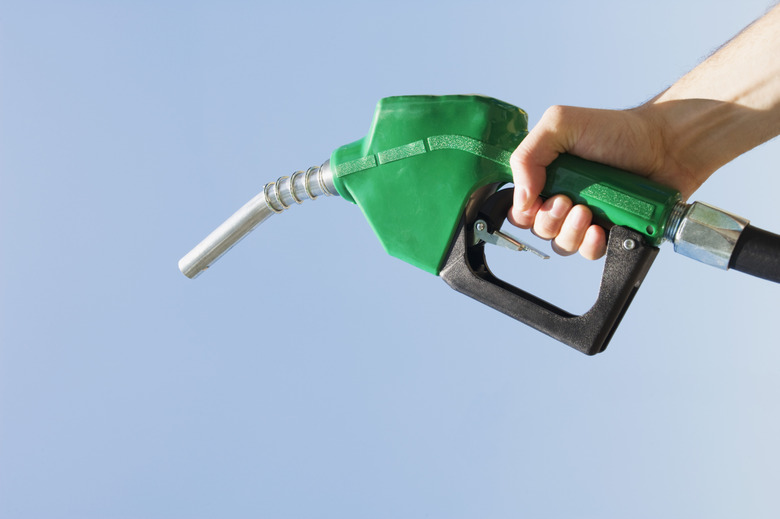Pros And Cons Of Algae Biodiesel
Dependency on foreign oil, high oil prices and environmental concerns have intensified the search for an alternative fuel. Freshwater algae, or pond scum, promises to be an efficient, environmentally friendly source of biodiesel. Algae use photosynthesis to produce lipids, or oils, in a process that uses up carbon dioxide. Algae can be grown in open-pond systems or in closed-tank bioreactors. High oil-producing algae strains, harvested daily by environmentally friendly methods, may liberate us from fossil fuel dependency. However, we need to consider the pros and cons of algae biodiesel before investing in this technology.
A Renewable Resource
A Renewable Resource
Unlike coal, natural gas and petroleum, oil derived from algae is a renewable resource. Algae grow rapidly, doubling their biomass within hours. Strains of algae that grow well and produce high amounts of oil can produce sufficient biodiesel to replace an estimated 48 percent of imported U.S. oil for transportation, according to a study, published in Water Resources in 2011. Compared with other sources of biofuels, such as corn, algae can produce about 80 times more oil per acre. Algae, unlike some other biofuel sources, is also not a major food source.
Algae Biodiesel is Carbon Dioxide Neutral
Algae Biodiesel is Carbon Dioxide Neutral
Algae use carbon dioxide, water, nutrients (fertilizer) and solar energy to make sugars, which they further metabolize into lipids, or oil. Algae biodiesel is net carbon neutral, because the carbon dioxide produced by burning algae biodiesel is the same amount of carbon dioxide that the algae took up to grow and produce the oil. If power plants capture their carbon dioxide, nearby built algae biofuel facilities could readily use the carbon dioxide and avoid transportation costs and accompanying greenhouse gas emissions.
Efficient Land Use
Efficient Land Use
Algae can grow in almost any climate as long as there is sufficient sunlight. Forests don't have to be cut down and algae facilities can use land that is not useful for agriculture. Production of algae biodiesel is more efficient than that of other biofuels, generating a higher energy yield per acre. For example, algae biofuel is at least 80 times more efficient per acre than soybean biofuel as estimated by National Geographic.
High Water Use
High Water Use
Large amounts of water are needed to grow algae in open ponds or closed bioreactors. Maintaining a high enough temperature for efficient algae growth causes water to evaporate. Algae biodiesel production uses more water than other biofuel sources. Water resources needed for agriculture may have to be diverted. New studies address the use of waste water and recycling of used algae water for a more efficient production of algae biodiesel.
High Fertilizer Use
High Fertilizer Use
Growing algae, a plant-like material, requires large quantities of fertilizer. To produce 39 billion liters of algae biodiesel, which would replace about 5 percent of total U.S. transportation fuel, algae growers would need 6 to 15 million metric tons of nitrogen and 1 to 2 million metric tons of phosphorus, which is about 50 percent of what is currently used in U.S. agriculture, according to a 2012 report by the National Research Council. Also, some of the nutrients in the fertilizer are made from petroleum sources. Run-offs, containing fertilizer products from algae facilities, may pollute water sources. Studies are underway to develop efficient recycling methods that will return phosphorus and nitrogen from used or left over algae biomass back into the growth media for new algae growth.
High Cost of Algae Biodiesel
High Cost of Algae Biodiesel
The production cost of algae biodiesel is high and the technology is new and still developing. Investors are wary of investing in algae biodiesel production, but may invest after improvement in efficiencies and if petroleum prices continue to rise.
References
- Scientific American: Is Algae the Biofuel of the Future?
- Science News: Large-scale Algae Biofuels Currently Unsustainable, New Report Concludes
- Green Car Congress: NRC Report Finds that Large-Scale Production of Biofuels Poses Sustainability Concerns; Not a Definite Barrier
- National Geographic: Green Dreams
Cite This Article
MLA
Blue, Marie-Luise. "Pros And Cons Of Algae Biodiesel" sciencing.com, https://www.sciencing.com/pros-cons-algae-biodiesel-6863/. 24 April 2017.
APA
Blue, Marie-Luise. (2017, April 24). Pros And Cons Of Algae Biodiesel. sciencing.com. Retrieved from https://www.sciencing.com/pros-cons-algae-biodiesel-6863/
Chicago
Blue, Marie-Luise. Pros And Cons Of Algae Biodiesel last modified August 30, 2022. https://www.sciencing.com/pros-cons-algae-biodiesel-6863/
